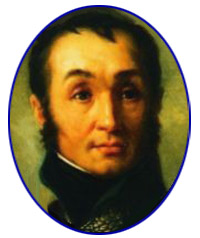

Click to see full text of the Chapter victor_ivanov@ukr.net
Argument of the Chapter
ōMarshal Nicolas Charles Oudinotö
Early years. Service in the Royal Army. Revolution. Service in the National Guard. Oudinot as a lieutenant colonel of volunteer regiment of Meuse. Brave defense of the Ritche castle. A brigade commander. Career with length of 34 wounds. Success in the fight at Gundershofen. Service in Rhenish and Mosel Armies.
Campaign of 1794. Participation in the fight at Kaiserslautern. The grade of brigade general. Campaign of 1795. Crossing the Rhine river. The Austrian captivity and homecoming. Friendship with general Davout. Participation in the campaign of 1796. The siege of Ingolstadt fortress.
Retreat maneuver of MoreauÆs army. Occupation of Mayence and capture of Meinheim bridgehead. Taking part in preparation of landing operation to British isles. Oudinot as a brigade commander in Helvetian Army of Massena.
Campaign of 1799. Operational plans of the sides. Offensive of Helvetian Army. Antagonism with Austrian Corps commander Hotze. Failure at Fielkirch. Preparation for general assault of the city. Success, supported with personal bravery. Capture of Grison fortress. A grade of division general. OudinotÆs son as the future commander. Offensive at Zurich. The battle at Limmat river. Capture of Zurich. Oudinot as the head of Staff of the Ligurian (Italian) Army during the campaign of 1800. Participation in defense of Genoa fortress. Oudinot as the inspector general of infantry and cavalry. Elite grenadier Corps commander. Characteristic of Imperial Guard. A case during NapoleonÆs visit to Boulogne military camp.
The Austrian campaign of 1805. The battle at Furnbach. Capture of Vienna. Case at the Thabor bridge. The battle at Hollabrunn. Fearless attack at Grund. The role of a mobile reserve at └usterlitz. Occupation of princedom Neuchatel. State of grenadiers troops on the eve of campaign of 1806.
The Prussian campaign of 1806. Reorganization of the Guard. The campaign of 1807. The battle at Ostrolenka. Participation in the siege of Danzig. The battle at Heilsberg. The battle at Friedland. Conflict between Oudinot and Savary, the Minister of Interior. The meeting of French and Russian emperors in Erfurt. Reorganization of the Guard in 1808-1809.
The Austrian campaign of 1809. The mistakes of marshal Berthier. Defeat of HillerÆs Corps. Attack on the Moosburg bridge. Courage of general Claperode. Occupation of Vienna. Beach-head on the Lobau island. The battle at Aspern-Essling. Oudinot takes command of the Corps after marshal Lannes. The battle at Wagram. Attacks on Baumersdorf on the first day of the battle. MarshalÆs baton. Lack of military education. Marshal Oudinot as the Brabant Army commander. Conflict with Louis Bonaparte, the King of Holland.
Marshal Oudinot as the Duke of Reggio. The Dutch Observation Corps commander. Occupation of Holland by OudinotÆs armies. Marshal Oudinot as the governor of Berlin and Elbe Corps commander. Preparation for the Russian campaign. Crossing the Neman river. Support of the marshal Macdonald Corps offensive. His way of behaviour with local population. The battle at Vilkomyr. Aimless march at the left coast of Dvina. The description of Daugavpils fortress. Unsuccessful frontal storm of the city. Successful nightly cavalry attack. Skirmishes in the vicinities of Polotsk. Fights in the bogs of Khodanui. General Verdier. Defeat of KulnewÆs Russian cavalry group. General Legrand. Unsuccessful storm of Klyaistitsa. A wound in battle at Polotsk on August 17. A task of support the retrograde maneuver of the Grand Army. The Russian ōpincersö. Successful fights against Wiettgenstein. Rescue from the trap on Berezina. Deceitful demonstration against Chychagow. Rest in France by state of health. Defense of Pleschanitsy.
The campaign of 1813. The battle at Bautzen. Death of Grand-Marshal Duroc. The second Saxonian campaign. Failure at Luckau. Offensive to Berlin. Defeat in Gross-Beeren. Unfair discharge from command. Failure at Dennewitz. Command of the Young Guard. The battle at Leiptzig. ┬efense at Wahau. The rear guard of recessive army. Campaign of 1814. Brienne, Nangis, Montereau, Bar-sur-Aube. Transition to the party of Louis XVIII. Marshal Oudinot as the commander of the National Guard of Paris.
Participation in the Spanish campaign of 1823. Service to Louis-Phillip. Marshal Oudinot as the governor of the InvalidÆs House. Death. Analysis of military leaderÆs career of marshal Oudinot.
Maps of the Chapter ōMarshal Nicolas Charles Oudinot"
1. The vicnities of Kaiserslautern.
2. Battle at Klyaistitsa.
3. Crossing over Beresina.
4. Situation in Germany (August 16, 1813).
5. The battle-field at Gross-Beeren (map 1).
6. The battle-field at Gross-Beeren (map 2).
7. The battle-field at Gross-Beeren (map 3).
8. The battle-field at Gross-Beeren (map 4).
9. The battle-field at Gross-Beeren (map 5).
10. Battle at Dennewitz.
11. Main maneuvers of the French campaign1814.
12. Strategical situation to February 14, 1814.
13. Battle at Arcis-sur-Aube.
14. Battle at Montereau.
Illustrations of the Chapter ōMarshal Nicolas Charles Oudinotö
1. Portrait of general Delmas.
2. Portrait of general Korsakow.
3. Portrait of Prince de Conde.
4. Portrait of general Dupas.
5. Portrait of general Duroc.
6. Entrance of Oudinot to Berlin, 1806.
7. Portrait of general Concroix.
8. Portrait of general Colbert.
9. Portrait of marshal Oudinot.
10. The DukeÆs of Reggio Arms.
11. Portrait of Louis Bonaparte.
12. Portrait of general Eble.
13. Portrait of madame Oudinot.
14. Portrait of general Schwarzenberg.
15. Portrait of general Corbineau.
16. Portrait of general Berkheim.
17. The Foreign LegionsÆs of Oudinot corps uniforms:
Ģ Portuguese chasseur;
Ģ Portuguese officer of light cavalry;
Ģ Croatian voltiguer;
Ģ Swiss tambour.
18. Portrait of general Lanskoy.
19. Portrait of general Bertrand.
20. Portrait of general Arrighi.
21. Portrait of general Fournier.
22. Portrait of general Regnier.
23. Portrait of general Tauentzien.
24. The Prussian batallionÆs attack at Gross-Beeren.
25. The Saxon Army uniforms:
Ģ Infantry officer, 1813;
Ģ Uhlan of prince ClementÆs regiment;
Ģ Officer-cuirassier, 1813;
Ģ Officer-hussar, 1813.
26. Portrait of King Louis-Philippe.
27. Marshal OudinotÆs grave in Hotel of Invalides.
The structure of military-historical monograph
½Military campaigns of NapoleonÆs marshals╗
Preface.
Introduction.
Chapter 1 ¢ marshal Jean Baptiste Jules Bernadotte, Prince of Ponte Corvo (1763-1844).
Chapter 2 ¢ marshal Louis Alexander Berthier, Prince of Neuchatel, Prince of Walange, Prince of Wagram (1753 ¢ 1815).
Chapter 3 ¢ marshal Jean Baptiste Bessieres, Duke of Istria (1768-1813).
Chapter 4 ¢ marshal Guillaume-Marie-Anne Brune (1763-1815).
Chapter 5 ¢ marshal Victor Claude Victor-Perrin, Duke of Belluno (1764 ¢ 1841).
Chapter 6 ¢ marshal Laurent Gouvion Saint-Cyr, marquess (1764-1830).
Chapter 7 ¢ ņÓ°Óļ Emmanuel Robert de Grouchy, marquess (1766-1847).
Chapter 8 ¢ marshal Louis Nicolas Davout, Duke of Auerstaedt, Prince of Eckmuhl (1770-1823).
Chapter 9 ¢ marshal Jean Baptiste Jourdan, count (1762-1833).
Chapter 10 ¢ marshal Francois Etienne Christophe Kellermann, Duke de Valmy (1735-1820).
Chapter 11 ¢ marshal Jean Lannes, Duke of Montebello (1769-1809).
Chapter 12 ¢ marshal Francois Joseph Lefebvre, Duke of Danzig (1755-1820).
Chapter 13 ¢ marshal Jacques-Etienne-Joseph-Alexander Macdonald, Duke of Tarente (1765-1840).
Chapter 14 ¢ marshal Auguste Frederic Louis de Viesse Marmont, Duke of Ragusa (1774-1852).
Chapter 15 ¢ marshal Andre Massena, Duke of Rivoli, Prince of Essling (1758-1817).
Chapter 16 ¢ marshal Bon Adrien Jeannot Moncey, Duke of Conegliano (1754-1842).
Chapter 17 ¢ marshal Adolphe Edouard Casimir Joseph Mortier, Duke of Treviso (1768-1835).
Chapter 18 ¢ marshal Joachim Murat, King of Naples (1767-1815).
Chapter 19 ¢ marshal Michel Ney, Duke of Elchingen, Prince of Moskwa (1769-1815).
Chapter 20 ¢ marshal Pierre Francois Charles Augerau, Duke of Castiglione (1757-1816)
Chapter 21 ¢ marshal Dominique-Catherine Perignon, marquis de Grenade (1754-1818).
Chapter 22 ¢ marshal Joseph Antoine Ponyatovsky, prince of Poland (1763-1813).
Chapter 23 ¢ marshal Jean-Mathieu Philiber Serurier (1742-1819).
Chapter 24 ¢ marshal Nicolas Jean de Dieu Soult, Duke af Dalmatia (1769-1851).
Chapter 25 ¢ marshal Louis Gabriel Suchet, Duke of Albufera (1770-1826).
Chapter 26 ¢ marshal Nicolas-Charles Oudinot, Duke of Reggio (1767-1847).
Conclusions.
Literature.